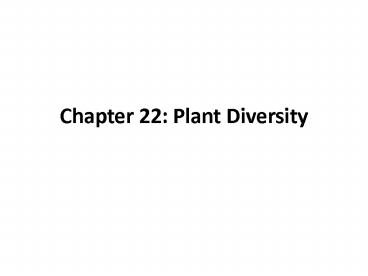Chapter 22: Plant Diversity PowerPoint PPT Presentation
Title: Chapter 22: Plant Diversity
1
Chapter 22 Plant Diversity
2
Comparison of Water and Land as Habitats for
Plants
WATER LAND
Water Close to each cell Under land surface, evaporates quickly above surface
Minerals Close to each cell On or under land surface
Gases Dissolved at low concentrations Plentiful in the air
Support Provides buoyancy, support Much less support for parts in air
Light Cuts out some wavelengths and lowers intensity Much light available
Temperature Little fluctuations, slow change Changes more rapid, wider extremes
Reproduction Motile gametes swim Water seldom available for swimming gametes
Dispersal Water carries offspring to new locations Water seldom available to carry offspring to new locations
3
Adaptations of Land Plants to Terrestrial
Environments
PROBLEM ADAPTATION
Obtaining water and mineral nutrients when they no longer surround entire plant Rhizoids or roots
2. Transporting water within the plant Xylem
3 Transporting food from sites of manufacture to sites of use Phloem
4. Preventing evaporation from surfaces exposed to air Cuticle
5. Obtaining gases for photosynthesis and respiration Stomata
6. Obtaining sunlight for photosynthesis Leaves
7. Supporting body in medium lacking buoyancy Xylem
8. Coordinating plant growth and plant response to changes in the environment Hormones
9. Getting gametes to together without reliable supply of water for sperm Pollen
10. Dispersing new individuals to suitable locations Airborne spores, then seeds
4
(No Transcript)
5
Differences Between Bryophyta and Tracheophyta
BRYOPHYTA TRACHEOPHYTA
No vascular tissue Vascular tissue present in sporophytes
2. No true roots, stems, leaves rootlike rhizoids anchor plant and absorb water Most modern forms have roots, stems, and leaves in sporophyte generation
3. Not more than a few cm tall Usually more than a few cm high
4. Sporophyte dependent on gametophyte generation Sporophyte independent, self-sufficient
5. Gametophyte generation dominant Sporophyte generation dominant
6. Gametophyte independent, self-sufficient Gametophyte independent (lower vascular plants) or dependent on sporophyte (gymnosperms and angiosperms
7. Water needed for swimming sperm during sexual reproduction Water needed for swimming sperm except in angiosperms and higher gymnosperms
8. Lack of vascular tissue restricts to moist envs Wide range of habitats
6
A. Metaphyta Plant Kingdom
- 1. Bryophyta (Phylum)
- Simpler plants lack vascular system (transport
tubes such as xylem phloem) - Depend on H2O to a greater extent than vascular
plants - Ex mosses liverworts
7
Moss
8
- 2. Tracheophyta (Phylum)
- Higher plants
- 3 main groups possess water vascular system, so
LESS DEPENDENT ON H2O mosses (evolutionary
advantage) - 1. P. Pterophyta (ferns)? sperm require water
for fertilization - 2. Gymnosperms/ conifers (cone-bearing)? most
ancient seed plants - - POLLEN TUBE carries sperm- adaptation for
terrestrial life - 3. Angiosperms/ flowering plants? POLLEN TUBE
carries sperm - - Adaptation for terrestrial life/ life cycle
9
(No Transcript)
10
Tracheids
11
B. Processes Essential to Sexual Reproduction
- 1. Meiotic Cell Division? reduces species
chromosome number by ½? haploid gametes - 2. Fertilization? restores species chromosome
number (egg sperm nuclei fuse- forms zygote) - Haploid (n) cell has one member of each pair of
chromosomes - Diploid (2n) cell has both members of each
chromosome pair
12
C. Reproduction in Mosses Ferns
- Alternation of Generations? life cycle in which a
spore producing plant (sporophyte) alternates
with a gamete producing plant (gametophyte) - a. Sexual reproduction by a gametophyte
alternates with - b. Asexual reproduction by a sporophyte
- Mosses? common moss plant is the gametophyte
- Ferns? common fern plant is the sporophyte
- NOTE
- Review life cycles handout
- Life cycles dependent upon water for
fertilization - Habitat restricted/limited by water
13
Plant Life Cycle
- Have 2 alternating phases known as Alternation
of Generations - 1. diploid phase (2N)? sporophyte /
spore-producing plant - 2. haploid phase (N)? gametophyte/
gamete-producing plant)
14
Moss Life Cycle
15
Fern Life Cycle
Prothallus- gametophyte
16
D. Alternation of Generations (Plant
Reproduction)
- 1. What are the generations?
SPOROPHYTE GAMETOPHYTE
Ferns Leaf-like frond (dominant) Heart-shaped
Mosses Stalk/capsule Short leafy shoot (dominant)
Flowers Entire plant (dominant) Pollen grain/ ovule
17
Cont. Alternation of Generations
- Which plants have ONLY ONE kind of gametophyte
and which plants have TWO KINDS of gametophytes - Can you tell why???
- FERNS? ONE gametophyte --- Has both antheridia
AND archegonia - MOSS? TWO gametophytes --- Antheridia and
archegonium on separate leaf-like stalks - FLOWERS? TWO gametophytes --- Microscopic pollen
and ovule
18
Cont. Alternation of Generations
- 3. What alternates?
- Processes Mitosis/ meiosis/ fertilization
- Nutrition Dependent (hetertrophic)/
independent (autotrophic) - Chromosome Diploid/ haploid
- Size Dominant (large/ conspicuous)/ not
dominant (smaller/ inconspicuous) - Duration Most of life cycle/ short time period
- Sex Asexual (spores)/ sexual (gametes)
19
- 4. In plant reproduction, what stage is between
the diploid parent plant and the diploid young
offspring plant? - Haploid gametophyte stage
- 5.In plant reproduction, what cell division
process is used to make the gametes? - Mitosis- gametophytes are haploid
20
SUMMARY OF MAJOR PLANT CHARACTERISTICS
(METAPHYTA)(Autotrophic, multicellular, cell
wall of cellulose
COMMON NAME PHYLUM NAME VASCULAR TISSUE ORGANS LIFE CYCLE HABITAT
Mosses Liverworts Bryophyta Absent No true roots, stems, leaves Need water for Gametophyte dominant, fusion of egg sperm fertilization! Moist areas
Ferns (Felicineae) Tracheophyta (Pterophyta) Present/ xylem phloem True roots, leaves, develop from rhizome (underground stems) Need water for Sporophyte dominant, distinct multicellular gametophyte (prothallium) fertilization! Moist areas
Conifers (Gymnospermae) Wind-pollinated Tracheophyta (Coniferophyta) Present/ xylem phloem True roots, stems, leaves Pollen tube Sporophyte dominant, seeds cones carries sperms Wide-spread
Flowering Plants (Angiospermae) Most evolutionary advanced plants Wind/ animal-pollinated Tracheophyta (Anthophyta) Present/ xylem phloem True roots, stems, leaves Pollen tube Sporophyte dominant, floweres seeds carries sperms Wide-spread
21
(No Transcript)

